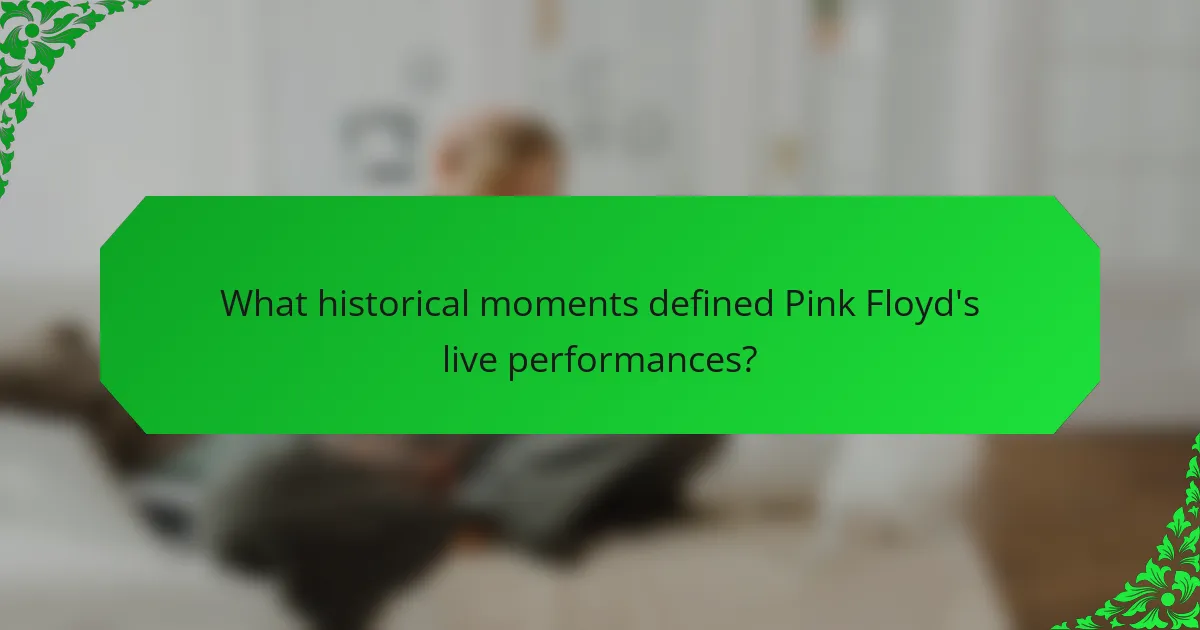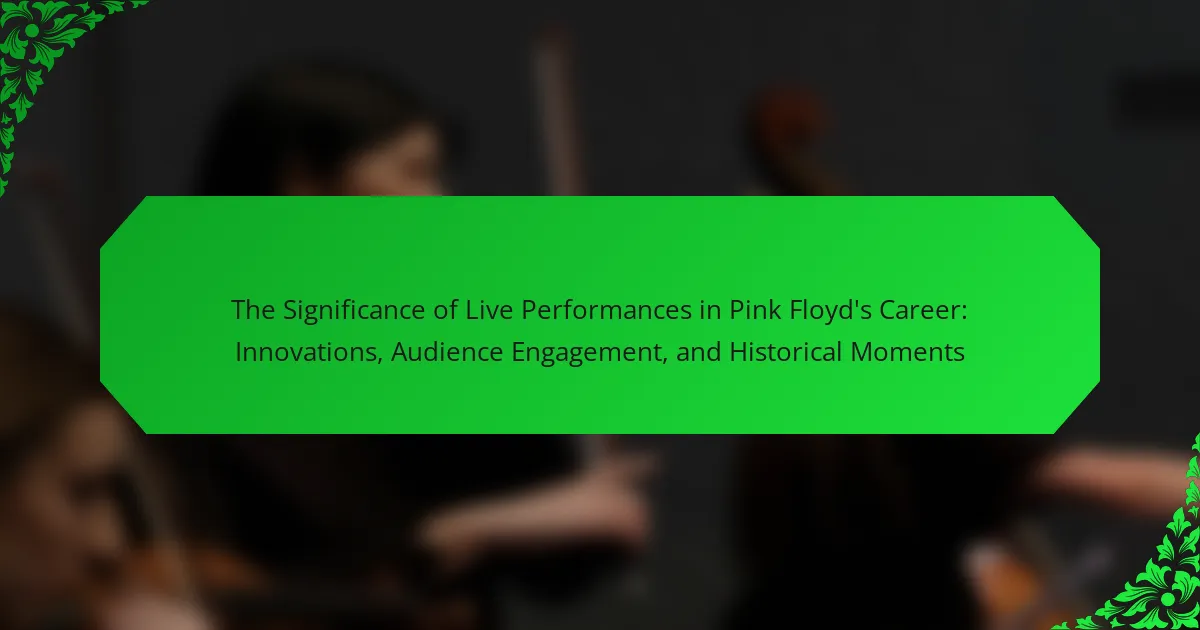Pink Floyd, a pioneering rock band, significantly shaped the music landscape through their innovative live performances. These concerts were characterized by elaborate stagecraft, groundbreaking technology, and immersive experiences that captivated audiences. Key historical moments include their 1973 “The Dark Side of the Moon” tour, the politically charged 1977 “Animals” tour, and the iconic 1980-81 “The Wall” tour, which featured dramatic visual storytelling. Pink Floyd’s commitment to integrating music with visual artistry not only enhanced audience engagement but also solidified their reputation as a leading live act, illustrating the importance of creativity and meticulous planning in redefining the concert experience.

What is the significance of live performances in Pink Floyd’s career?
Live performances were crucial to Pink Floyd’s career. They showcased the band’s innovative sound and elaborate stagecraft. The group’s concerts became legendary for their visual effects and immersive experiences. Pink Floyd’s live shows often featured groundbreaking technology, such as quadraphonic sound systems. Their 1973 tour for “The Dark Side of the Moon” solidified their reputation as a leading live act. The band used performance as a platform to explore complex themes and narratives. Iconic moments, like the 1977 “Animals” tour, highlighted their political commentary. Overall, live performances helped define Pink Floyd’s identity and expand their influence in music history.
How did live performances shape Pink Floyd’s musical identity?
Live performances significantly shaped Pink Floyd’s musical identity by enhancing their experimental sound and visual artistry. Their concerts became a platform for innovative audio-visual experiences. The band’s use of elaborate light shows and projections created a unique atmosphere. This approach allowed them to engage deeply with their audience. Iconic performances, such as the 1972 “The Dark Side of the Moon” tour, showcased their evolving musical complexity. The integration of themes and narratives during live shows reinforced their conceptual album format. Furthermore, live performances influenced their studio recordings by pushing creative boundaries. The improvisational elements in concerts contributed to their distinctive sound. Overall, live performances were essential in defining Pink Floyd’s artistic legacy.
What key innovations in live performances did Pink Floyd introduce?
Pink Floyd introduced several key innovations in live performances. They were pioneers in the use of elaborate visual effects. This included large-scale projections and laser shows. Their performances often featured immersive stage designs. These designs transformed the concert experience into a multi-sensory event. The band also utilized quadraphonic sound systems. This technology provided a more spatial audio experience for the audience. Additionally, Pink Floyd was known for integrating narrative elements into their shows. This created a cohesive thematic experience throughout their concerts. Their landmark performance of “The Wall” in 1980 showcased these innovations. It included a massive wall built on stage, which was torn down during the show.
How did these innovations influence the music industry?
Innovations in live performances significantly transformed the music industry. These advancements enhanced audience engagement through immersive experiences. Technologies like elaborate light shows and surround sound systems created a multi-sensory environment. This increased the emotional connection between artists and fans. The introduction of large-scale concerts set new standards for production value. Artists began to prioritize visual elements alongside musical performance. The shift encouraged the development of new revenue streams, such as merchandising and ticket sales. As a result, live performances became essential to an artist’s success and branding.
Why are audience engagement and experience important in Pink Floyd’s live shows?
Audience engagement and experience are crucial in Pink Floyd’s live shows because they enhance the overall impact of the performance. The band’s elaborate visual effects and soundscapes create an immersive atmosphere. This engagement fosters a deeper emotional connection between the audience and the music. Historical performances, such as the 1973 “The Dark Side of the Moon” tour, showcased their innovative use of technology. This included synchronized light shows and projections that captivated audiences. By prioritizing audience experience, Pink Floyd transformed concerts into multi-sensory events. Their focus on engagement has set a standard in live music that continues to influence artists today.
How did Pink Floyd connect with their audience during performances?
Pink Floyd connected with their audience during performances through innovative visuals and immersive soundscapes. They utilized elaborate light shows, projections, and stage designs to enhance the experience. Their performances often featured thematic storytelling, engaging the audience emotionally. The use of live instruments combined with pre-recorded audio created a unique atmosphere. Additionally, the band encouraged audience participation through sing-alongs and interactive elements. Their iconic album “The Wall” was performed with a narrative that resonated deeply with fans. This combination of artistry and emotional connection solidified their bond with the audience.
What unique elements contributed to audience engagement in their shows?
Unique elements that contributed to audience engagement in Pink Floyd’s shows include immersive visual effects and elaborate stage designs. Their use of innovative lighting and projections created a captivating atmosphere. This was complemented by their distinctive soundscapes, which enhanced the emotional impact of the music. Live performances often featured extended instrumental sections, allowing for audience connection. The integration of thematic narratives in their concerts fostered deeper engagement. Pink Floyd’s willingness to experiment with technology, like quadrophonic sound, also set them apart. These elements combined to create a memorable experience that resonated with fans.

What historical moments defined Pink Floyd’s live performances?
Pink Floyd’s live performances were defined by several historical moments. One significant event was the 1971 performance of “The Dark Side of the Moon” at the Rainbow Theatre in London. This concert showcased their innovative use of visual effects and soundscapes. Another notable moment occurred during the 1977 “Animals” tour, which featured elaborate stage designs and political commentary. The 1980-81 “The Wall” tour was groundbreaking, featuring a massive wall built on stage that was torn down during the performance. Their 1994 reunion at the Barbican was also historic, marking their first performance together in over a decade. These moments highlighted Pink Floyd’s commitment to merging music with visual artistry and their influence on the concert experience.
How did specific concerts impact the band’s legacy?
Specific concerts significantly impacted Pink Floyd’s legacy by showcasing their innovative sound and visual artistry. The 1971 concert at the Paris Theatre highlighted their experimental approach with live improvisation. This performance solidified their reputation as pioneers of progressive rock. The 1973 “The Dark Side of the Moon” tour introduced elaborate light shows and thematic storytelling. This tour became a defining moment in live performance history, influencing future artists. The 1994 reunion at the Barbican marked a significant moment in their history, reuniting the original members after years apart. This event reignited interest in their music and underscored their lasting impact on rock culture. Each of these concerts contributed to their identity as a band that pushed creative boundaries.
What were the most iconic live performances in Pink Floyd’s history?
The most iconic live performances in Pink Floyd’s history include their 1970 performance at the Isle of Wight Festival. This event showcased their progressive rock sound to a massive audience of over 600,000 people. Another significant performance was their 1973 concert at the Rainbow Theatre in London. This concert featured the debut of “The Dark Side of the Moon” material, which later became a landmark album. The 1994 Division Bell tour is also notable, as it marked the band’s reunion after years apart. This tour included elaborate stage designs, highlighting their innovative approach to live shows. Lastly, their 1990 performance at the Berlin Wall’s demolition is iconic for its historical significance. This event symbolized freedom and unity, drawing a global audience. Each of these performances contributed to Pink Floyd’s legacy as pioneers in live music experiences.
How did external factors influence these historical moments?
External factors significantly shaped Pink Floyd’s historical moments. Political climates influenced the band’s themes and performances. For instance, the Vietnam War prompted anti-war sentiments in their music. Social movements of the 1960s and 1970s also affected audience engagement. Changes in technology allowed for innovative stage designs and effects. The rise of stadium rock created larger audiences for their live shows. Economic conditions impacted ticket prices and concert accessibility. Cultural shifts led to evolving musical styles, reflecting broader societal changes. These external influences collectively defined Pink Floyd’s impact on music history.
What role did technology play in Pink Floyd’s live performances?
Technology played a crucial role in Pink Floyd’s live performances. The band utilized advanced sound systems to enhance audio quality. They incorporated elaborate light shows, including lasers and projections, to create a multi-sensory experience. The use of innovative stage designs, such as large inflatable props, captivated audiences visually. Additionally, they employed synchronized video displays to complement their music. Pink Floyd’s integration of technology transformed concerts into immersive art experiences. This approach set new standards for live performances in rock music. Their 1973 tour for “The Dark Side of the Moon” exemplified this, featuring cutting-edge sound and visuals. Overall, technology was integral to Pink Floyd’s identity and impact as a live act.
How did advancements in technology enhance their shows?
Advancements in technology significantly enhanced Pink Floyd’s shows. The use of advanced sound systems improved audio clarity and quality. Innovations in lighting technology created immersive visual experiences. The integration of video projections added dynamic storytelling elements to performances. High-definition screens allowed for detailed imagery that captivated audiences. Laser technology introduced stunning visual effects that complemented the music. These technological enhancements transformed live shows into multi-sensory experiences. Such innovations set a new standard for concert performances in the music industry.
What were some groundbreaking techniques used in their performances?
Pink Floyd utilized groundbreaking techniques such as elaborate visual effects and innovative sound design in their performances. They were pioneers in using large-scale projections and light shows to enhance the concert experience. Their use of quadrophonic sound systems created an immersive audio environment. The incorporation of theatrical elements, such as props and costumes, added a narrative dimension to their shows. Notably, the performance of “The Wall” featured a physical wall built during the concert, symbolizing isolation. They also employed advanced technology like synthesizers and tape loops to create unique soundscapes. These techniques significantly influenced live music production and audience engagement. Their performances set new standards for concert experiences in the rock genre.

What lessons can be learned from Pink Floyd’s approach to live performances?
Pink Floyd’s approach to live performances teaches the importance of visual storytelling and immersive experiences. They integrated elaborate stage designs and visual effects, enhancing audience engagement. Their use of innovative technology, like quadrophonic sound, transformed the concert experience. Pink Floyd also emphasized thematic consistency, aligning visuals with the music’s narrative. Their performances often included dramatic elements, making each show a unique event. This approach cultivated a strong emotional connection with the audience. Additionally, they demonstrated the value of meticulous planning and rehearsal in executing complex productions. Overall, Pink Floyd’s performances illustrate how creativity and innovation can redefine live music.
How can contemporary artists apply Pink Floyd’s performance strategies?
Contemporary artists can apply Pink Floyd’s performance strategies by integrating multimedia elements into their shows. Pink Floyd was known for their elaborate light shows and visual effects. This combination enhanced the emotional impact of their music. Artists today can use projections, LED screens, and immersive environments to create a similar experience.
Additionally, Pink Floyd often incorporated storytelling into their performances. This narrative approach helped to engage audiences on a deeper level. Contemporary artists can develop thematic concepts that resonate with their audience’s experiences.
Collaboration with visual artists is another strategy. Pink Floyd frequently worked with designers to create cohesive visual themes. Modern artists can partner with visual creatives to enhance their performances.
Finally, Pink Floyd’s focus on audience interaction is crucial. They often encouraged audience participation, making the experience memorable. Contemporary artists should consider ways to involve their audience more actively during live shows.
What best practices from Pink Floyd’s live shows can enhance modern performances?
Incorporating immersive visual effects is a best practice from Pink Floyd’s live shows that can enhance modern performances. Their use of elaborate light shows and projections created a captivating atmosphere. This approach engaged audiences on multiple sensory levels. Additionally, integrating thematic storytelling into performances deepens emotional connections. Pink Floyd’s concerts often conveyed narratives that resonated with fans. Utilizing high-quality sound systems is another key practice. Their meticulous attention to audio fidelity ensured an exceptional listening experience. Finally, encouraging audience participation can elevate the performance. Pink Floyd often involved fans through sing-alongs and interactive elements. These practices collectively create memorable and impactful live experiences.
How can artists balance innovation and audience connection in their live shows?
Artists can balance innovation and audience connection in their live shows by integrating new technologies while maintaining familiar elements. They can introduce unique visual effects and interactive experiences that captivate audiences. Simultaneously, artists should ensure that their core musical elements resonate with the audience’s expectations. Engaging with fans through storytelling or relatable themes enhances emotional connection. Research indicates that live performances with a blend of innovation and familiarity increase audience satisfaction. For example, studies show that concerts featuring both classic hits and innovative arrangements create memorable experiences. This approach not only showcases creativity but also reinforces the bond with the audience.
The main entity of the article is Pink Floyd, a renowned rock band known for their innovative live performances. The article examines the significance of these performances in shaping the band’s musical identity, highlighting key innovations such as elaborate visual effects, quadraphonic sound systems, and thematic storytelling. It also explores the historical moments that defined their live shows, the impact of technology on their performances, and the lessons contemporary artists can learn from Pink Floyd’s approach to audience engagement and experience. Overall, the content provides a comprehensive overview of how live performances contributed to Pink Floyd’s legacy and influence in the music industry.
